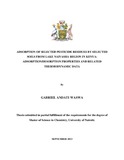Adsorption Of Selected Pesticide Residues By Selected Soils From Lake Naivasha Region In Kenya: Adsorption/desorption Properties And Related Thermodynamic Data
Abstract
The adsorption/desorption properties of soils in aqueous solution from Lake Naivasha by 1-
naphthol N-methylcarbamate (Carbaryl) and N-(3,4-dichlorophenyl)-N,N-dimethyl urea
(Diuron) was studied in terms of the first order model of a binary solution expressed as:
nX S SXn
and K [SX ] /[X] [S] n
n , ………………(1)
X is the chemical species of interest (pesticide) , S is the substrate (soil particles), K is the
adsorption/desorption equilibrium constant and n SX is the particle-pesticide complex. According
to this model, the apparent adsorption/desorption equilibrium constant K‟ is given by equation 2:
ln[x]ads = ln(nk‟) + n(ln[x]e + [sxn]w )…………….….(2)
where [ X ]ads is concentration of X in adsorbed state in suspension. [ X ]e is the concentration
of X in solution at equilibrium. [ n SX ]w is the pesticide adsorption site complex in the
suspension at equilibrium.
The significance of the study was to determine the thermodynamic and kinetic properties of these
two pesticides in order to ascertain their environmental impact in view of necessary remedies.
The mathematical simplicity of the first order model of a binary solution makes it preferred for
this study, since changes in concentration of the pesticide can be used to predict the sorption of
the organic compound in the soil. The experimental procedures involved spiking varied masses
of the soil with varied concentrations of the pesticides and shaking for different time intervals to
attain equilibration. Concentrations of adsorbed pesticide were obtained by analyzing the
aqueous phase medium using UV-Visible spectrophotometer and finding the differences from
the initial concentrations. Generated plots were used to determine related thermodynamic
parameters.
The average values of ' K (the apparent adsorption/desorption equilibrium constant), n and G'
(the apparent adsorption/desorption free energy) for Lake Naivasha soils obtained for Carbaryl
were 20.56, 0.63 and -7.26 KJ/mol respectively.
The average values of ' K , n and ' G obtained for Diuron were 18.33, 0.57 and -7.08 KJ/mol
respectively.
For both Carbaryl and Diuron, the ΔG values are negative which indicates a spontaneous
sorption process. The values of n above obtained for Carbaryl and Diuron are less than unit,
suggesting that each molecule of the pesticide is associated with a single adsorption sites.
Lastly, the main difficulty experienced in this adsorption/desorption work with respect to the
method and instrumentation used was with regard to the time taken for equilibration to occur.
Better equilibration for adsorption experiments are attained over longer shaking times and
settling intervals
Citation
Master of Science in ChemistryPublisher
University of Nairobi

